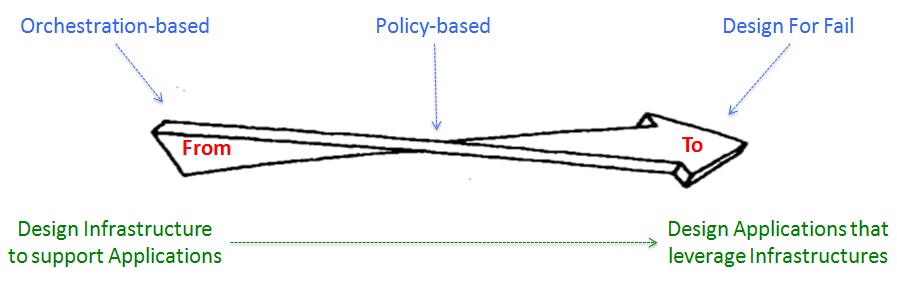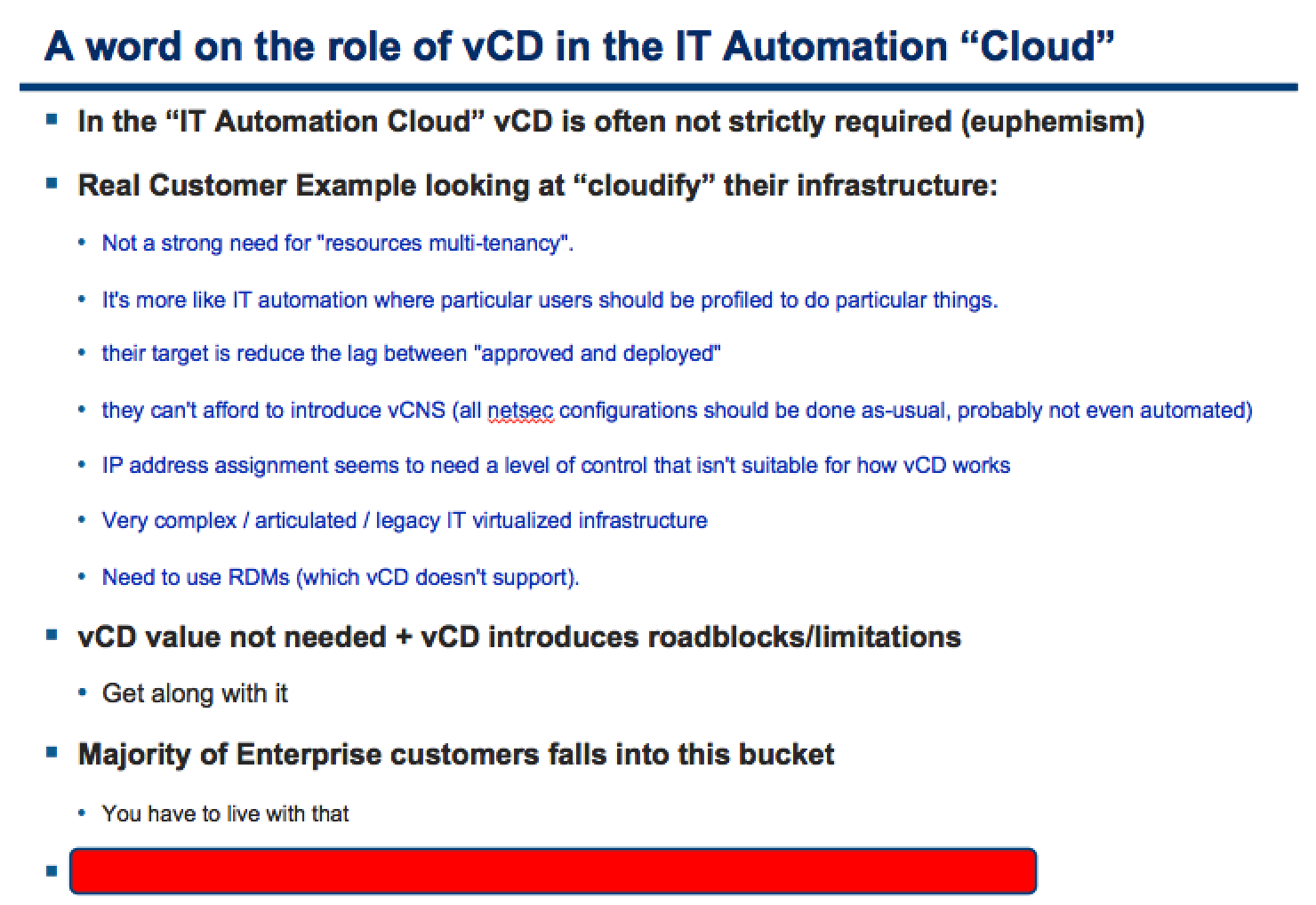A Tail of Wrong Assumptions That Lead to Wrong Conclusions
Yesterday morning I woke up and found myself being mentioned in one of Randy Bias' blog posts on the Amazon Vs VMware battle.
As I was reading thorough the article I found hard to disagree with what Randy was saying. I am not referring specifically to his conclusions (more on this later) but rather to the general sense of the blog post in terms of efficiency of scale and stuff like that.
But as I went through it I found the caveat.
"..they [VMware] can see that enterprise virtualization clouds are like the ASP model and have a very short shelf life. Enterprises need a different kind of cloud. An elastic cloud. Unfortunately, VMware’s key technologies don’t allow you to build an elastic cloud based on VMware..."
No, Randy, I am sorry. I think there is a typo. You should have said "a very small subset of Enterprises need a different kind of cloud. An elastic cloud".
As per the "virtualization clouds... have a very short shelf life"... let me remind you that 1B+$ isn't just how much Amazon makes out of AWS. 1B+$ (roughly) is how much IBM makes out of the AS/400 (or whatever it is called 40 years later). Yes, a platform that was "dead" 10 years ago yet makes more money than AWS.
IBM has just announced a (yet another) new cloud platform based on OpenStack but keeps its balance in order by selling mainframes (and related services and software). As we already discussed many times on twitter, we agree on pretty much everything... we just either have a different time scale or live on different planets.
Sorry to rain on the party Randy, but OpenStack doesn't pay the bills as of yet. It may pay your bills and Mirantis' bills though, because there is a place for everyone on this planet and everyone can create his own niche. This niche will grow for sure, no doubt, but no one single technology will rule them all.
You live by "what's cool" today. That is nice and I think you have a great and fun job. The real life is different though. 95% of these Enterprise customers you mention can't afford that.
I don't want to repeat myself but I have already discussed this in the Cloud and the three IT geographies theory last year. I feel like we keep saying the same things over and over and over. I am wondering if these posts (mine and yours) are useful at all at this point.
This isn't to say OpenStack isn't a fit. I believe it will be successful and will find its place in the IT landscape. However picturing the world like OpenStack has won and VMware has lost sounds more like a marketing statement than a reality check.
Boris Renski puts it under the proper perspective:
The OpenStack view of the world involves starting from scratch. It is the philosophy where one says “let us forget about all those existing enterprise applications and automate the infrastructure in a way that carries no legacy dependencies”
That is so true. This is a picture I used in my Cloud Magic Rectangle to describe the transition to cloud:

The (true) cloud is all about applications that are designed to fit an (existing) infrastructure. This is how companies using AWS have built their applications.
There may be a very tiny number of Enterprise that are adopting (or will adopt shortly) this mantra. The majority of them, which I usually describe as being 95% (gut feeling), can't afford to do what Boris is suggesting. All they want to do is automate application deployments on both x86 and Unix and update not less than 37 legacy CMDBs. Yeah... an elastic cloud, go figure.
The only problem you had when you talked to the VMware executives is that they didn't give you visibility the RFPs these Enterprise customers keep feeding the vendors with (and will keep feeding the vendors with for the foreseeable future).
Oh, ironically I've just got off an internal thread where people were discussing that vCD brings too much advanced stuff on the table that these (95% of) Enterprise customers have problems digesting.
So much for "this is just virtualization 2.0 type of clouds".
Let me open a bit of my kimono here and share with you a slide (included in a large deck) I built last year.
Disclaimer: this is a personal slide and not a VMware slide.

The "IT Automation" cloud is the term I used in the deck to describe what these 95% of Enterprise customers are after. Which is definitely not cloud by any means.
Try to go there and sell OpenStack to these customers. Try to go there and tell them they need to start from scratch. Yeah good luck. And no, this isn't an exception, trust me.
I am pretty sure you are working with a lot of these Enterprise customers. I think you are making your fair amount of money with them consulting on OpenStack. However I am not discussing the 200K$ they are giving you. I am debating the 1B$ cheque they sign for all the other vendors selling other technologies. Yes 1B$ >> 200K$. It's math.
Don't get me wrong. As I said, customers that benefit from OpenStack exist and will grow in number.
However the solution cannot be, for a vendor, to move the entire estate of a company to capture those workloads by forgetting about all the other existing workloads. I am sensitive to the innovator's dilemma but I have always interpreted it as "how can you capture opportunities that go beyond your comfort zone?" Vs. "how quickly can you throw away what benefits your existing customers to jump onto the next cool thing?".
So the question I have had in my head for the last 2 years is.. can VMware adapt what it has today to capture these new and additional opportunities? Or does VMware need to build something new?
I can't possibly think that the answer to this dilemma is:
- Throw everything away but ESXi
- Use OpenStack on top
- Give 200M$ to Cloudscaling for consulting
Let's be serious.
I also think that you have been too generous to underline the challenges VMware has when you listed the 4 roadblocks we have to open the gate to support new workloads. I am quoting:
- VMware best practices, hardware compatibility lists, and reference architectures all focus on legacy scale-up, gold-plated approaches that needlessly increase costs.
- The VMW end-user license agreement (EULA) disallows the use of any other technology for managing their hypervisor (ESX/ESXi), particularly for hosting providers. You must deploy vCenter, vSphere, and vCloud, and the like.
- VMW’s current business model and revenue stream is dependent on selling the more expensive enterprise licenses that focus on technology irrelevant to an elastic cloud such as DRS, HA, and similar.
- The vCloud API is too focused on enterprise virtualization use cases (e.g. the whole vApp mess).
I don't think #1 is such a big deal. As we move towards a more software defined world the hardware dependencies and characteristics will become less relevant. Take VMware Distributed Storage for example. It is by the way ironic you claim that VMware architectures are driven by expensive enterprise hardware while (some of) VMware hardware partners feel and complain they are being commoditized by (some of) the VMware software features.
#2 and #3 are somewhat interlocked. I believe that if VMware was to find a way to make 6B$ a year by giving away ESXi and use OpenStack I am sure the executive team would be interested in that. Imagine how much we could save on R&D! Suggestions are welcome. There is also this little detail discussed above that without vCenter, vSphere and vCloud VMware won't be able to deliver what the customers deploying the VMware stack are getting (and OpenStack couldn't deliver with the cattle model).
#4 I don't necessarily disagree that vApps may be a pain sometimes (euphemism being abused). However I always try to look at the glass half full. I see vApps as suitable for those Enterprise customers that are looking at a gradual move from Paleolithic IT to a more service oriented experience. Admittedly it's not the AWS experience though, for good or bad.
So if we fix #1 (or the perception thereof), #4 and make vCloud work without DRS and HA (per #3)... do we have an elastic cloud? Deal! Where do I sign?
There are many other wrong assumptions in Randy's blog post that were naturally leading to the conclusion that VMware is toast: "As Massimo Re Ferrè of the VMware vCloud team has said before ... it is possible to build a less expensive VMware-based cloud. The cost of the hypervisor licensing itself is not the problem. The problem is that a less expensive VMware cloud has none of the advanced capabilities desired by enterprise customers looking to outsource..".
I don't want to start a big argument on this but.. what would these "advanced capabilities" VMware-based clouds do not have that OpenStack has? Last time I checked an OpenStack based cloud I could barely start and stop a VM and that was pretty much it. So what would these "advanced features" be? An object storage? An EBS like service? A shared and secured multitenant flat layer 2 network?
I believe VMware will get there eventually but... no Randy, today the majority of the Enterprise customers you are referring to don't need those things. They like having a SAN, update a CMDB (actually more than one) and are just not ready to adopt (massively) network virtualization.
While vCloud Director implements a "leaning backward" pets model... yet it is years ahead of its time given the cloud maturity level many of these Enterprise customers are at. Let alone the cattle model OpenStack implements.
While Randy pictures the VMware cloud stack as a technology of the past, for many of these Enterprise customers the VMware cloud stack (and the Software Defined Data Center concept in general) is what they see as an end-state.
So Randy, let's put sensationalism aside for a moment (and I know there have been many on all sides lately, sadly) and let's work towards educating the industry that there isn't going to be a one stack that rules them all.
And while we have been talking about VMware, OpenStack and AWS in the context of this post as well as yours... it must be noticed that vendors like Oracle, Microsoft, IBM, CA and BMC aren't going to disappear overnight. And, to be honest, based on my very own experience I am seeing them more in the accounts that I have been working with than I see OpenStack. Sure there may be a 4 nodes OpenStack / vCloud cluster under some geek's desk but guess who gets the 100M$ cheque at the end of the year? Yeah, that's right.
Massimo.